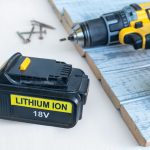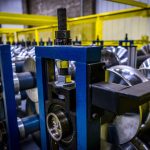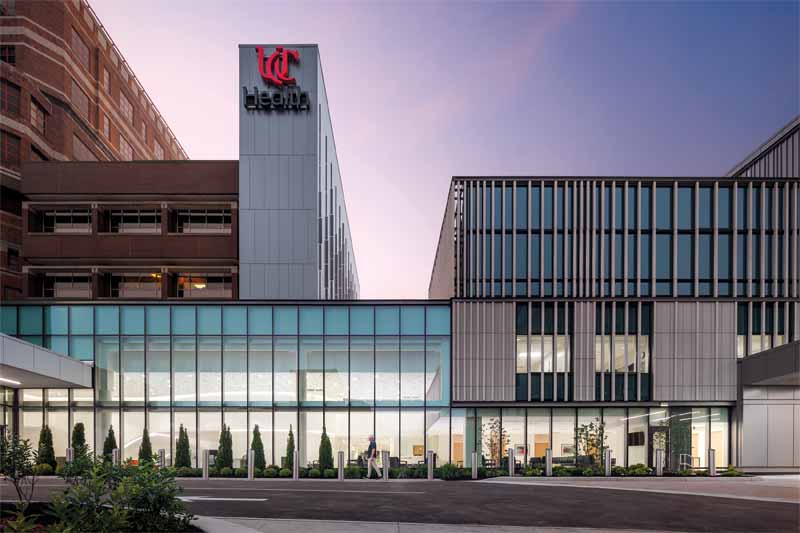
Healthcare systems and providers are continuing to invest in the construction of new facilities and renovating existing facilities to address community needs, expand services, and grow revenue.
Construction spending in the healthcare sector reached an estimated $58.8 billion in 2023, and spending is expected to increase 4.4 percent in 2024 and 5.4 percent in 2025, according to data from Dodge Construction Network. Construction firms surveyed by the Associated General Contractors of America and Sage expect the available dollar value of private sector projects to expand in 2024 in the categories of hospitals and non-hospital healthcare facilities such as clinics and medical labs.
As the construction of healthcare facilities continues to grow, design teams are prioritizing the selection of building material solutions that deliver high-performance healthcare facilities by boosting energy efficiency and lowering costs.
Insulated metal panels (IMPs)—exterior wall and roof panels with steel skins and an insulating foam core—deliver high energy performance, potentially lower embodied carbon compared to concrete, vast design flexibility, exceptional durability, ease of installation, and cost-effectiveness for healthcare facilities.
High energy performance
Energy performance is critical for healthcare buildings, which represent 4 percent of total commercial floorspace but account for approximately 9 percent of energy consumption in commercial buildings, according to the most recent data from the U.S. Energy Information Administration. With energy efficiency standards increasing every year, architects and designers are selecting IMPs for their high thermal performance.
IMPs offer R-values of up to R-8.0 per in., an extremely high level of insulation. An air and watertight continuous insulation barrier seals the building enclosure and helps inhibit energy loss. This thermal efficiency makes IMPs
a strong choice in the construction of large-scale buildings like hospitals.
Featuring a full air and water barrier and a core of continuous, rigid insulation, IMPs offer a significant advantage in thermal efficiency over traditional wall assembly mater for the same thickness. The built-in insulation in the high-performance metal panels creates an excellent barrier against heat transfer, helping energy-intensive healthcare facilities significantly reduce energy usage and costs, meet increasingly stringent energy codes, and maintain a comfortable indoor environment.
Lower embodied carbon
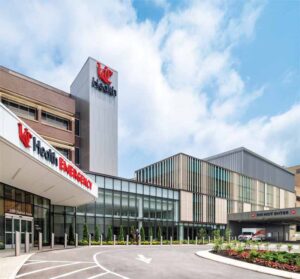
The built environment is widely known for being a major contributor to greenhouse gas emissions. According to Architecture 2030, the built environment generates 42 percent of annual global CO2 emissions. Of those total emissions, building operations (Scope 1 emissions) are responsible for 27 percent annually, and building and infrastructure materials and construction (Scope 3 emissions) are responsible for 15 percent annually. The healthcare sector’s overall emissions account for an estimated 8.5 percent of U.S. emissions.
As climate-damaging emissions continue to rise, industries across all sectors including the healthcare industry are increasing their commitments to decarbonization. Commitments to a reduced carbon footprint are a major force shaping the design and according to facilities in this sector.
According to the 2023 Hospital Construction Survey conducted by the American Society for Health Care Engineering’s (ASHE’s) Health Facilities Management magazine, 58 percent of the 200 healthcare facilities professionals who participated in the report indicated their organization has publicly committed to environmental sustainability and decarbonization goals. The report noted these goals are “directly impacting facility design and construction projects and processes by driving a shift in how these projects are approached.”
The energy-efficient properties of IMPs can help decrease carbon emissions and provide healthcare airtight and moisture resistant toward net zero energy for a high-performance building. Airtight and moisture resistant with a rigid, continuous-insulation envelope, IMPs offer high R-values and a strong thermal performance, which ultimately results in fewer greenhouse gas emissions, increased energy efficiency, and reduced energy costs.
Selecting IMPs with lower levels of embodied carbon can help healthcare facilities achieve Leadership in Energy and Environmental Design (LEED) certification healthcare projects that are certified and registered by LEED across the globe, representing approximately 86 million m2 (923 million sf).
Vast design flexibility
When it comes to design, high-performing building materials like IMPs can help healthcare facilities communicate brand image and identity.
IMPs come in a wide range of panel profiles and patterns, color options, and finishes that can be customized to fit any project’s design aesthetic. They can also be installed vertically or horizontally for more design options, adding even greater flexibility. This offers flexibility for design professionals, allowing them to create a distinctive look that better reflects a brand’s image and results in impactful designs that integrate seamlessly with a location’s aesthetic.
The design possibilities offered by IMPs mean architects do not have to sacrifice style for practicality or performance. IMPs can match any project’s aesthetic requirements, allowing them to be successfully utilized in healthcare construction projects of all sizes and scopes.
Exceptional durability
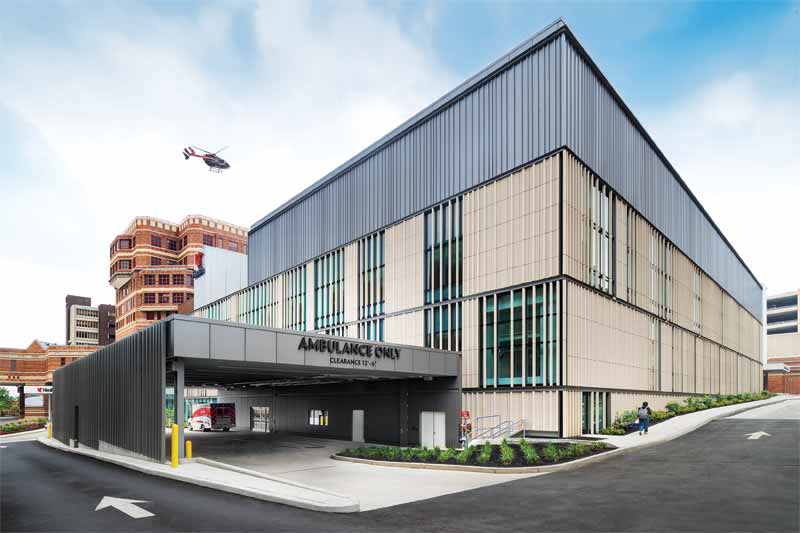
Durable building materials are essential in hospitals and other healthcare facilities which typically see high daily foot traffic. No matter where they are located, these buildings must also stand up to changing weather conditions.
Constructed of durable steel and designed to last for decades, IMPs can withstand inclement weather while remaining air and watertight. The durable design of IMPs also allows them to remain looking great while standing up to the daily wear and tear healthcare facilities experience. Ideal for the construction of healthcare buildings, these metal panels are low maintenance and easy to clean. Their tight-fitting interlocking joints provide a high-quality air and vapor barrier, which helps resist moisture.
Ease of installation
Building projects in the healthcare sector often have tight timelines, and the speed of building IMPs is another reason why they are selected as the building envelope solution for a wide range of projects in this sector, creating construction efficiencies that result in labor and cost savings.
These prefabricated lightweight, modular panels require one installer, rather than multiple trades, which can prevent scheduling delays. The increased build speed of these panels helps construction projects stay on track, reducing downtime and increasing on-time project completion.
Cost-effectiveness
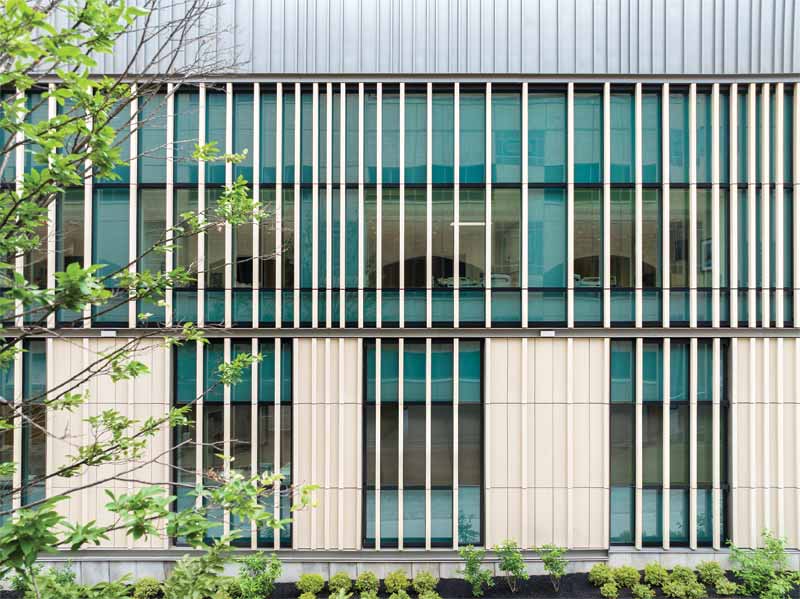
Inflation and shrinking profit margins in the healthcare industry are elevating the need for building materials that reduce costs and accelerate projects. Healthcare Design’s 2024 Architecture/Engineering/Construction Survey saw 30 percent of construction firms cite construction cost escalation and labor shortages as the biggest internal challenges they face.
IMPs are a cost-effective, easy-to-install building material, which can help overcome these challenges. A lightweight, single-component wall system, IMPs require less labor and less time to install than conventional multi-component wall assemblies, helping reduce construction costs and expensive delays.
One study found the installation costs of IMP wall systems were, on average, 25 percent lower in the United States, compared to insulated precast and tilt-up concrete walls.
IMPs in action in the healthcare sector
With the wide range of benefits provided by IMPs, it is no surprise this building envelope solution was selected by architects designing the expansion of the 30-year-old emergency department at the University of Cincinnati (UC) Medical Center. As the region’s only Level I trauma center for adults, the UC Medical Center needed to expand its capacity to provide emergency care to the growing region.
With the region’s increasing demand for emergency care, the speed of build in this renovation was important. Quick installation of IMPs provided a weathertight envelope in reduced time, drying in the emergency room faster and allowing for inside finish work to begin sooner. The fast-tracked construction prevented scheduling delays for on-time completion.
IMPs also provide thermal efficiency and energy efficiency benefits to the new emergency department. By creating air and watertight continuous insulation seals, IMPs provide strong thermal barriers to maintain safe and comfortable environments for patients. These insulation barriers also reduce energy consumption for large complexes like the UC Medical Center.
The wide range of available IMP design options also allowed architects to select panels conveying a unique, modern aesthetic that integrates with the theme of UC Health’s Clifton Campus revitalization.
When it comes to constructing high-performance facilities in the healthcare sector, IMPs are just what the doctor ordered, delivering more energy-efficient, aesthetic, durable, and cost-effective buildings.
Karim Muri is vice president of marketing services and strategy development for Kingspan Insulated Panels North America. Muri has led strategic marketing in the construction products market for nearly 20 years. His global experience includes leadership roles in the United States and Australia, working in both the residential and commercial building sectors.



